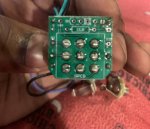Hello All, so where do I even begin this is gonna be a interesting one, hopefully we can trouble shoot it. I created the Seabed Delay Pedal, got it all boxed up but forgot to actually solder the stomp to the stomp pcb but everything else was connected. When the guitar is in bypass mode I get a full bypass guitar sound, and moving the pot controls does nothing. when I go ahead and activate the pedal, the volume drops to like 20%. All the controls still work for the effects it seems like they are just operating at 20%. If I crank the amp all the way up it gives me a beautiful delay that I would love to play around with, I just don't want to deactivate the pedal and the roof come off my house from having the amp cranked full blast.
On to the trouble shooting, so I went around and tried to re-solder most spots that I cant access. I replaced both ic chips and the transistor. nothing. So then i went and double checked all the resistors and all matched the value that the pcb called for. Double checked all the caps that were not sandwiched together( I always try and put the identification number on the outside) looks like they are correct but haven't confirmed all. Next step was to get all the reading:
IC2 PT2399
Pin 1: 4.92
Pin 2: 2.48
Pin 3: 0
Pin 4: .02
Pin 5: 2.57
Pin 6: 2.49
Pin 7: .28
Pin 8: .87
Pin 9: 2.49
Pin 10: 2.49
Pin 11: 2.49
Pin 12: 2.49
Pin 13: 2.49
Pin 14: 2.49
Pin 15: 2.49
Pin 16: 2.49
IC1 TL072
Pin 1: 4.10
Pin 2: 4.10
Pin 3: 4.08
Pin 4: 0
Pin 5: 8.20
Pin 6: 4.10
Pin 7: 4.10
Pin 8: 4.08
IC3 78L05
Pin 1: 8.20
Pin 2: 0
Pin 3: 4.98
On to the trouble shooting, so I went around and tried to re-solder most spots that I cant access. I replaced both ic chips and the transistor. nothing. So then i went and double checked all the resistors and all matched the value that the pcb called for. Double checked all the caps that were not sandwiched together( I always try and put the identification number on the outside) looks like they are correct but haven't confirmed all. Next step was to get all the reading:
IC2 PT2399
Pin 1: 4.92
Pin 2: 2.48
Pin 3: 0
Pin 4: .02
Pin 5: 2.57
Pin 6: 2.49
Pin 7: .28
Pin 8: .87
Pin 9: 2.49
Pin 10: 2.49
Pin 11: 2.49
Pin 12: 2.49
Pin 13: 2.49
Pin 14: 2.49
Pin 15: 2.49
Pin 16: 2.49
IC1 TL072
Pin 1: 4.10
Pin 2: 4.10
Pin 3: 4.08
Pin 4: 0
Pin 5: 8.20
Pin 6: 4.10
Pin 7: 4.10
Pin 8: 4.08
IC3 78L05
Pin 1: 8.20
Pin 2: 0
Pin 3: 4.98
Last edited:
















